Once upon a time there was an abandoned athletics track
To the west is the imposing Palazzo della Gherardesca, with its enormous garden enjoyed now exclusively by the wealthy guests of the Four Seasons hotel. To the north, near the ancient walls, is the English Cemetery with its cypresses and irises, the resting place of non-Catholic painters and poets who chose Florence as their home. To the south is the Cathedral, and a little further on the church at the center of the popular Sant’Ambrogio district and the Basilica of Santa Croce. To the east is the exclusive Piazza d’Azeglio, a slice of nineteenth-century life made specifically for the city’s upper middle class. Right in the middle, at Borgo Pinti number 76, is a void: a large red rectangle crossed by white stripes that sketch the outline of a decades-old abandoned athletics track that was rediscovered thanks to Google Maps.
It was there that Giacomo Salizzoni sought to stitch together these pockets of space that existed between the greenery and the city’s built-up areas, between the apartments (which can be isolating) and the community. He gathered wood, earth, seeds, rare plants, trees, vegetables, children, families and the elderly and gave them all something to do. Within a few months, his team of guerrilla gardeners performed miracles and that garden became an extraordinary permanent laboratory of good environmental practices.
Giacomo is there every morning, ready to tell anyone interested the story of a revived lemon tree, the unexpected properties of erba della Madonna, the miracles of earthworms in compost, the beauty of edible flowers, the efficiency of African Zeer pot refrigeration and terracotta olla pots for subterranean irrigation, how a tire can ingeniously become a swing and a metal hanger can morph into a beautiful sculpture.
The environment, circular economy, teaching, and sharing are the seeds that thrive in this unparalleled garden.
The collaboration
An experience worth sharing
After years of dedicating the pages of our Journal to telling the stories of the likes of Yacouba Sawadogo, Nemonte Nenquimo, Shyam Sunder Paliwal, Nalleli Cobo, Paul Sein Twa, Fiorenzo Caspon and other heroes who are fighting all over the world to change the future of our planet and the future of its people, we discovered that we had one of these heroes right in our backyard, a mere stone’s throw from our offices and the workshop where our company started.
With Giacomo and his incredible urban garden it was love at first sight. Smitten with his enthusiasm and joyful, tenacious ability to turn dreams into reality, we decided to share his story and, quietly, be a part of it, cultivating a social and environmental sustainability project with him.
It’s rare to have the privilege of combining one’s work and dreams, of joining the responsibilities we feel towards our company with the deep, shared joy a new project brings. It happened this time and Orti Dipinti has become dear to our hearts by offering a space that fosters freedom, where we’ve chosen to create the future that we’d like to nurture together. In telling this story our aim is to be ‘contagious’ and to involve other supporters in this extraordinary experience.
Luigi Ceccon
CEO of Il Bisonte S.p.A.
The founder
The bolognian in love with Florence
Born in 1975, Giacomo Salizzoni arrived in Florence from Bologna twenty-five years ago to study architecture and has never left. He loves his adopted city as much if not more than a Florentine, but he’s still able to see it from outside: he understands its limits and intuits its potential.
It took a non-native eye to notice from above the void in the urban fabric of Florence’s ancient center and to imagine filling it with a piece of the future. And it took genuine love to commit himself day after day to building it, despite bureaucratic obstacles and the reservations of neighbors who were living in a beautiful area that was becoming increasingly gentrified.
A sustainable lifestyle has always been his obsession: Giacomo carries a notebook with him everywhere, and whether you meet him by chance or invite him to dinner, he’s constantly taking it out to jot down a new idea or to talk about some ingenious method discovered in Iceland to store CO2, or that incredible trick they use in the Favelas to illuminate windowless shacks, or that flawless method of decorating cakes using leaves to stencil powdered sugar. Big and small things are forever whirling in his lively brain, and they turn into experiments and good practices worth sharing.
If you visit Florence, do not miss out on the opportunity to meet him.
The collaboration
An experience worth sharing
After years of dedicating the pages of our Journal to telling the stories of the likes of Yacouba Sawadogo, Nemonte Nenquimo, Shyam Sunder Paliwal, Nalleli Cobo, Paul Sein Twa, Fiorenzo Caspon and other heroes who are fighting all over the world to change the future of our planet and the future of its people, we discovered that we had one of these heroes right in our backyard, a mere stone’s throw from our offices and the workshop where our company started.
With Giacomo and his incredible urban garden it was love at first sight. Smitten with his enthusiasm and joyful, tenacious ability to turn dreams into reality, we decided to share his story and, quietly, be a part of it, cultivating a social and environmental sustainability project with him.
It’s rare to have the privilege of combining one’s work and dreams, of joining the responsibilities we feel towards our company with the deep, shared joy a new project brings. It happened this time and Orti Dipinti has become dear to our hearts by offering a space that fosters freedom, where we’ve chosen to create the future that we’d like to nurture together. In telling this story our aim is to be ‘contagious’ and to involve other supporters in this extraordinary experience.
Luigi Ceccon
CEO of Il Bisonte S.p.A.
Once upon a time there was an abandoned athletics track
To the west is the imposing Palazzo della Gherardesca, with its enormous garden enjoyed now exclusively by the wealthy guests of the Four Seasons hotel. To the north, near the ancient walls, is the English Cemetery with its cypresses and irises, the resting place of non-Catholic painters and poets who chose Florence as their home. To the south is the Cathedral, and a little further on the church at the center of the popular Sant’Ambrogio district and the Basilica of Santa Croce. To the east is the exclusive Piazza d’Azeglio, a slice of nineteenth-century life made specifically for the city’s upper middle class. Right in the middle, at Borgo Pinti number 76, is a void: a large red rectangle crossed by white stripes that sketch the outline of a decades-old abandoned athletics track that was rediscovered thanks to Google Maps.
It was there that Giacomo Salizzoni sought to stitch together these pockets of space that existed between the greenery and the city’s built-up areas, between the apartments (which can be isolating) and the community. He gathered wood, earth, seeds, rare plants, trees, vegetables, children, families and the elderly and gave them all something to do. Within a few months, his team of guerrilla gardeners performed miracles and that garden became an extraordinary permanent laboratory of good environmental practices.
Giacomo is there every morning, ready to tell anyone interested the story of a revived lemon tree, the unexpected properties of erba della Madonna, the miracles of earthworms in compost, the beauty of edible flowers, the efficiency of African Zeer pot refrigeration and terracotta olla pots for subterranean irrigation, how a tire can ingeniously become a swing and a metal hanger can morph into a beautiful sculpture.
The environment, circular economy, teaching, and sharing are the seeds that thrive in this unparalleled garden.
The founder
The bolognian in love with Florence
Born in 1975, Giacomo Salizzoni arrived in Florence from Bologna twenty-five years ago to study architecture and has never left. He loves his adopted city as much if not more than a Florentine, but he’s still able to see it from outside: he understands its limits and intuits its potential.
It took a non-native eye to notice from above the void in the urban fabric of Florence’s ancient center and to imagine filling it with a piece of the future. And it took genuine love to commit himself day after day to building it, despite bureaucratic obstacles and the reservations of neighbors who were living in a beautiful area that was becoming increasingly gentrified.
A sustainable lifestyle has always been his obsession: Giacomo carries a notebook with him everywhere, and whether you meet him by chance or invite him to dinner, he’s constantly taking it out to jot down a new idea or to talk about some ingenious method discovered in Iceland to store CO2, or that incredible trick they use in the Favelas to illuminate windowless shacks, or that flawless method of decorating cakes using leaves to stencil powdered sugar. Big and small things are forever whirling in his lively brain, and they turn into experiments and good practices worth sharing.
If you visit Florence, do not miss out on the opportunity to meet him.
The map of Orti Dipinti
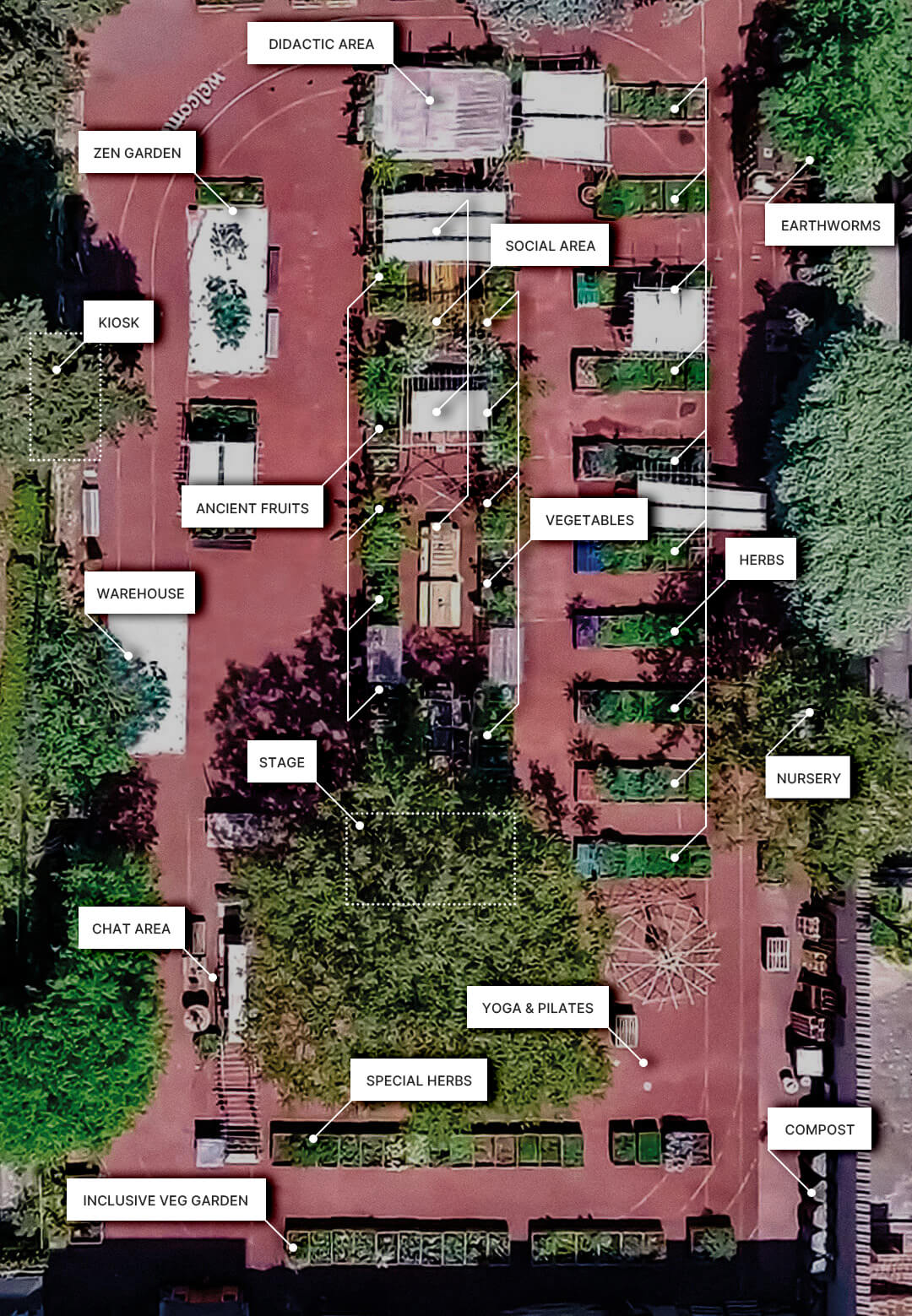
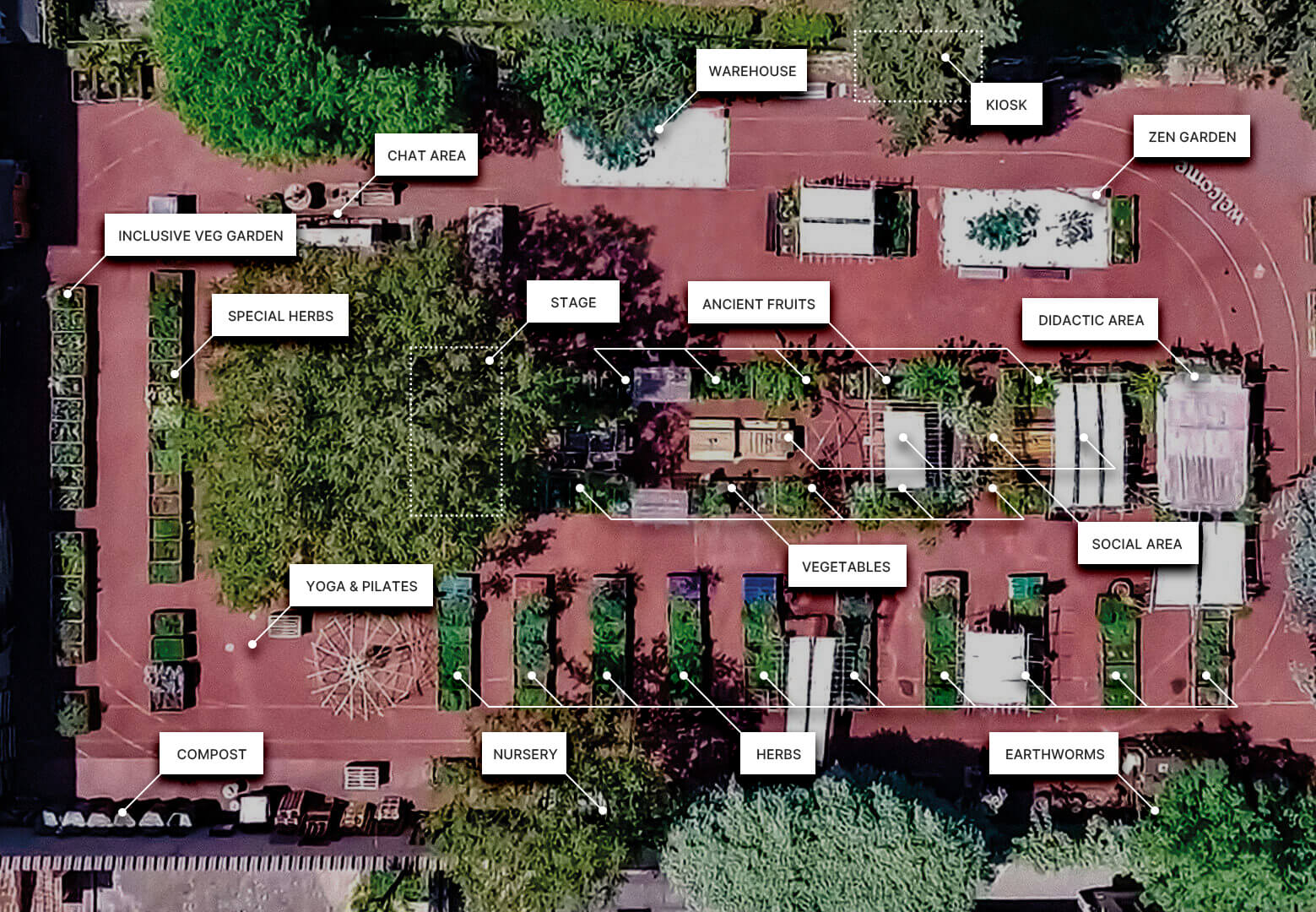
In the shade of trees
APRICOTS, VINES AND A POPLAR CARRIED ON THE WIND
Among the cracks in the concrete, in the flowerbeds carved out where the long jump once took place, in large wooden crates made from pallets, in old oak barrels cut in half and repurposed as flower pots: the Orti Dipinti trees thrive where ever they find space.
Vines climb up poles marking off the area where food for lunches, dinners and snacks is prepared. The ancient apricot tree full of delicious fruit shades the tables where people read, draw or work every morning. The climbing plants that wind along the perimeter walls mark the change in seasons with their intense colors. An aspen, which started out on a nearby terrace and was transplanted in the garden to give it enough space to expand, now supports a hammock that beckons you to relax.
A snapshot of daily life in the Gardens: slow and simple like the miracle of a tree that grows in spite of everything.
Together is better
NATURALLY INCLUSIVE
Agronomists offering advice, and chefs in search of aromatic herbs; grandparents and children playing with wheelbarrows or making leaf and flower collages; tourists and residents alike who meet for an aperitif; activists and curious passersby; students from international universities and community service workers: there is a place and something for everyone at Orti Dipinti.
Just ask Giacomo and he’ll set you up right away watering vegetables or pulling weeds and clearing away dry leaves to make compost, fixing tools or building support frames for the climbing plants. And for those who can play an instrument, sing or act there is always a stage available.
Children with special needs from the adjacent social cooperative Gaetano Barberi are also pillars of the community garden. They all participate in the project based on their skills and sensitivity. Don’t miss the chance to admire the fruits of their labor: the beautiful colored terracotta decorations that peek out among the flowers and vegetables.
Rediscovering diversity
IT’S EASY TO SAY MINT
What do we learn in the gardens? Simple things, forgotten tricks, good daily practices, healthy eating, circular economy. The many workshops available to individuals and schools include ones on how to make infusions, scented water or herbal bouquets to hang in the kitchen to be used both fresh and dried; workshops on discovering the surprising healing properties of “erba della Madonna”; and ones on composting (everything, including pee!) and learning about the truly useful, and very tough work earthworms do. You learn how to make friends with aphid-repelling ladybugs, to eat flowers, to help each other out by growing vegetables, to make cuttings and to create 100% natural mosquito repellent.
But most importantly you rediscover the value of diversity and association; you get back to nature and its infinite variations, and experience its richness and power with all your senses. At Orti Dipinti, a love for bio-diversity blooms with a whiff of yellow or red sage, banana or strawberry mint. Try it, you’ll see!
Luigi and Giacomo
IL BISONTE’S GREENHOUSE
L: “What do you need here, Giacomo?”
G: “Lighting for when we stay after sunset and a new irrigation system that saves time and water.”
L: “And? Anything else?“
G: “Then there’s my dream of a large greenhouse in iron and glass where when it rains we can hold meetings and lessons on good practices for everyone, from kindergartners on. But it costs a lot of money, everything is self-financed here and we can’t afford it.”
L: “Write up a good plan and fill the greenhouse with great ideas. We’ll take care of managing and financing it.”
The first meeting between Giacomo Salizzoni and Luigi Ceccon went exactly like this. The lights, all energy efficient LEDs, have already been installed as well as the irrigation system. The educational greenhouse will be ready before next spring. The rest will come by itself, through the collaboration between the Orti, Il Bisonte and anyone else who wants to support this project.
Orti Dipinti’s good practices
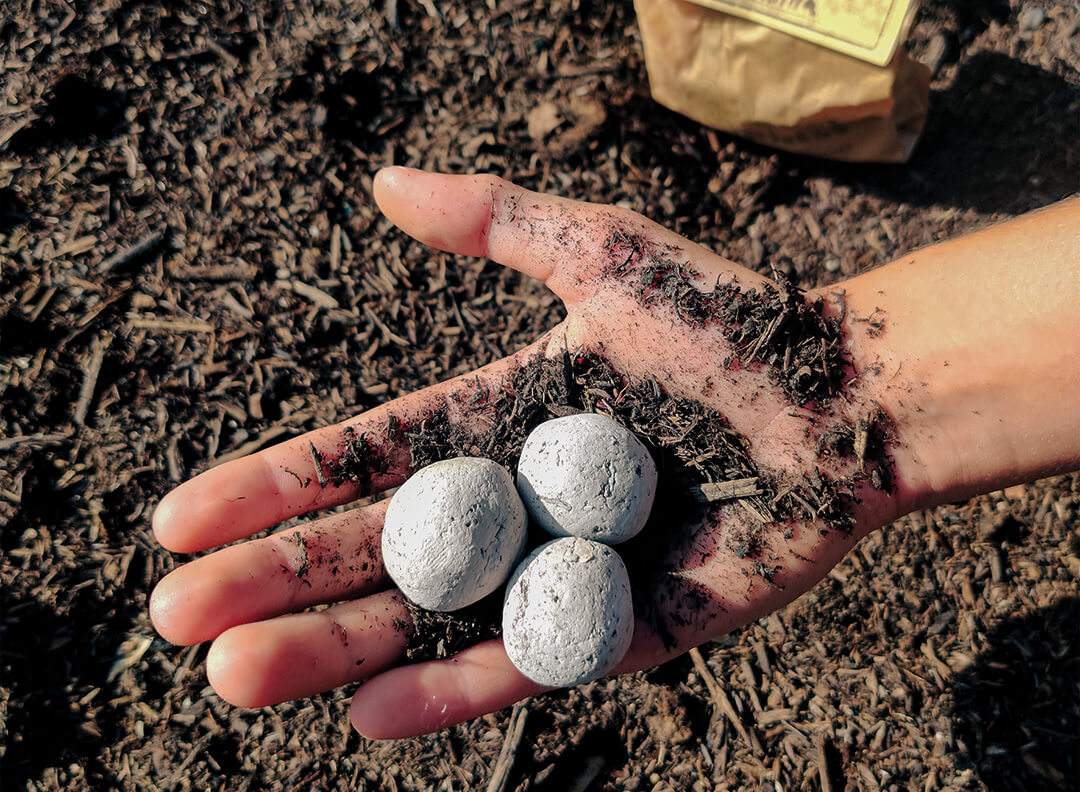
Good practices #1
Becoming an “Eco-vandal”
How long has it been since you got your hands muddy? At least five decades, right? No problem, we’ll give you a great reason to start getting marvelously dirty like you loved to do as a child.
Gather some seeds, mix 1 tablespoon of seeds with 5 tablespoons of clay, 3 tablespoons of peat-free soil and 2 tablespoons of water. Make dumpling-size balls and leave them to air dry. Then wrap them in tissue paper, twisting them up like a piece of candy. Take them with you and whenever you see a sad or desolate area of town, toss your “seed bombs” there on the ground. Something new and beautiful might just sprout!
“Invented” by the Japanese botanist and philosopher Masanobu Fukuoka, “seed bombs” are one of the most common forms of peaceful green protest and a gentle invitation to regenerate cities.
Giacomo recommends building your own little “Seed Bank” by collecting the seeds from the fruit you eat and then planting them later.
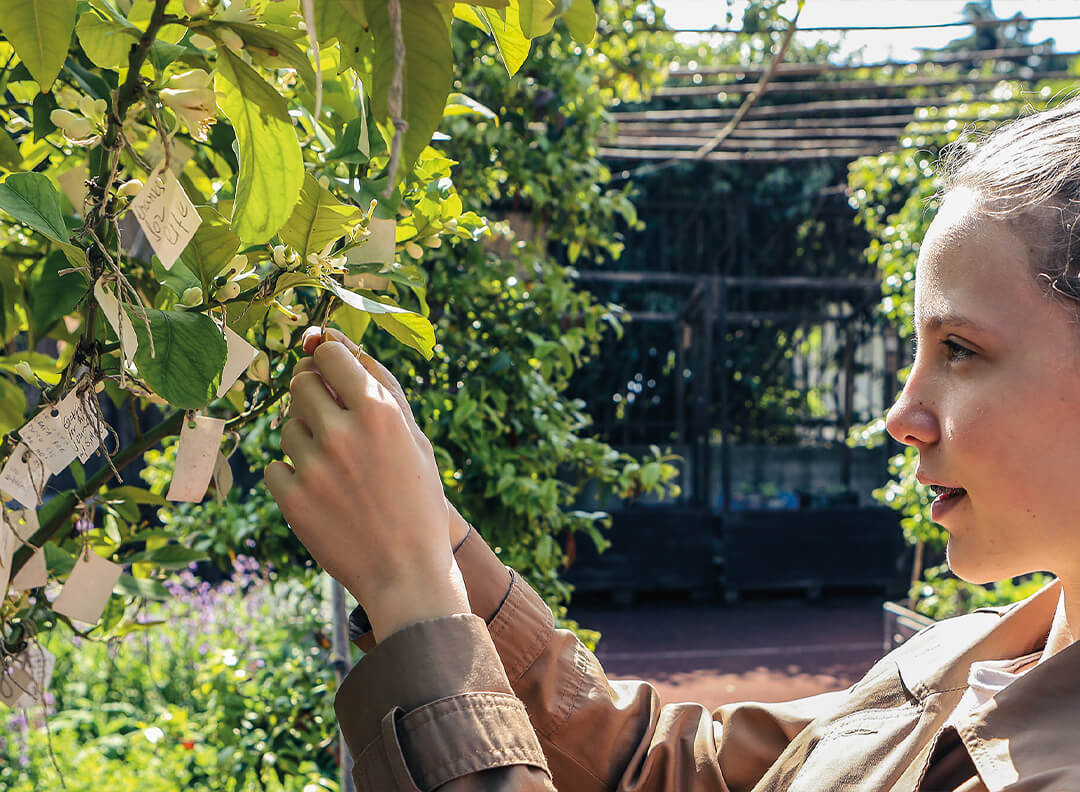
Good practices #2
Talk to plants. Even better, write to them
Talk to plants. Or even better, write to them. They may not listen to you, let alone read your words, but surely the time you dedicate to talking will slow down your pace and allow you to take care of them properly and notice if they have any particular needs.
The almost-dead, completely fruitless lemon tree that arrived at Orti Dipinti was reborn this way: it became a tree where grateful people could hang daily thank-you notes. The director of the plant neurobiology laboratory in Florence, Stefano Mancuso, confirms that it works, and we bet your psychotherapist would appreciate it too.
Giacomo recommends googling “Don José Carmen Garcia Martinez” and/or reading his book “El Hombre que Habla con las Plantas.” We can’t guarantee that you’ll be able to miraculously grow 1.5 meter-long beets, 5-meter-high corn stalks and 45 kg cabbage, but we bet the story of this wise Mexican farmer will enchant you, and your thumb might be a little greener.
Good practices #2
Talk to plants. Even better, write to them
Talk to plants. Or even better, write to them. They may not listen to you, let alone read your words, but surely the time you dedicate to talking will slow down your pace and allow you to take care of them properly and notice if they have any particular needs.
The almost-dead, completely fruitless lemon tree that arrived at Orti Dipinti was reborn this way: it became a tree where grateful people could hang daily thank-you notes. The director of the plant neurobiology laboratory in Florence, Stefano Mancuso, confirms that it works, and we bet your psychotherapist would appreciate it too.
Giacomo recommends googling “Don José Carmen Garcia Martinez” and/or reading his book “El Hombre que Habla con las Plantas.” We can’t guarantee that you’ll be able to miraculously grow 1.5 meter-long beets, 5-meter-high corn stalks and 45 kg cabbage, but we bet the story of this wise Mexican farmer will enchant you, and your thumb might be a little greener.

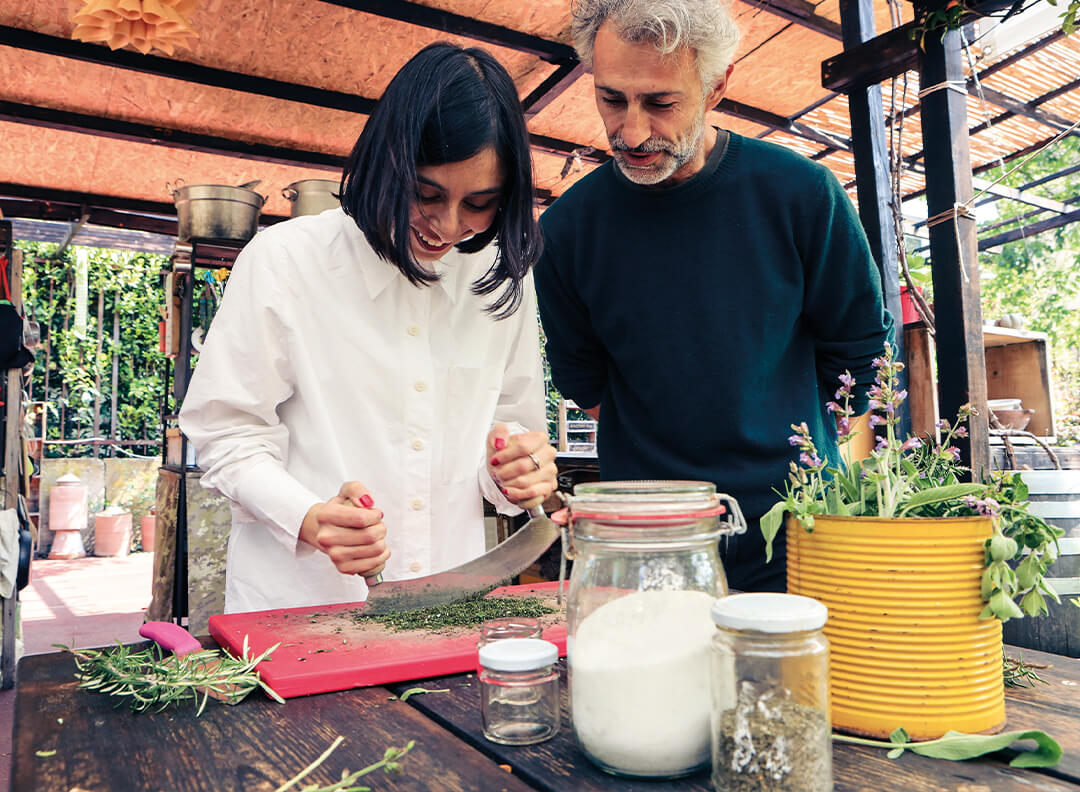
Good practices #3
Keep in shapes with herbs
A glass jar, washed and sterilized in boiling water.
A handful of salt.
A bunch of dried herbs, picked up on a walk or left over in the kitchen.
Nothing else is necessary to produce a magnificent herbal salt and preserve the scent of all your favorite herbs.
If you’re conservative, play it safe with sage, rosemary and bay leaves, but if you like to experiment, go ahead and discover new combinations by mixing savory, thyme and mint; celery, parsley and chives; lavender, lemon verbena and lesser calamint. At Orti Dipinti you can dabble as much as you want: more than seventy varieties of aromatic herbs grow here in wooden crates.
Giacomo recommends not using the mixer to chop up herbs! The heat produced during electric chopping alters the properties and flavor of the herbs. Better to work out your arms and hands a bit with a pestle or mezzaluna knife.
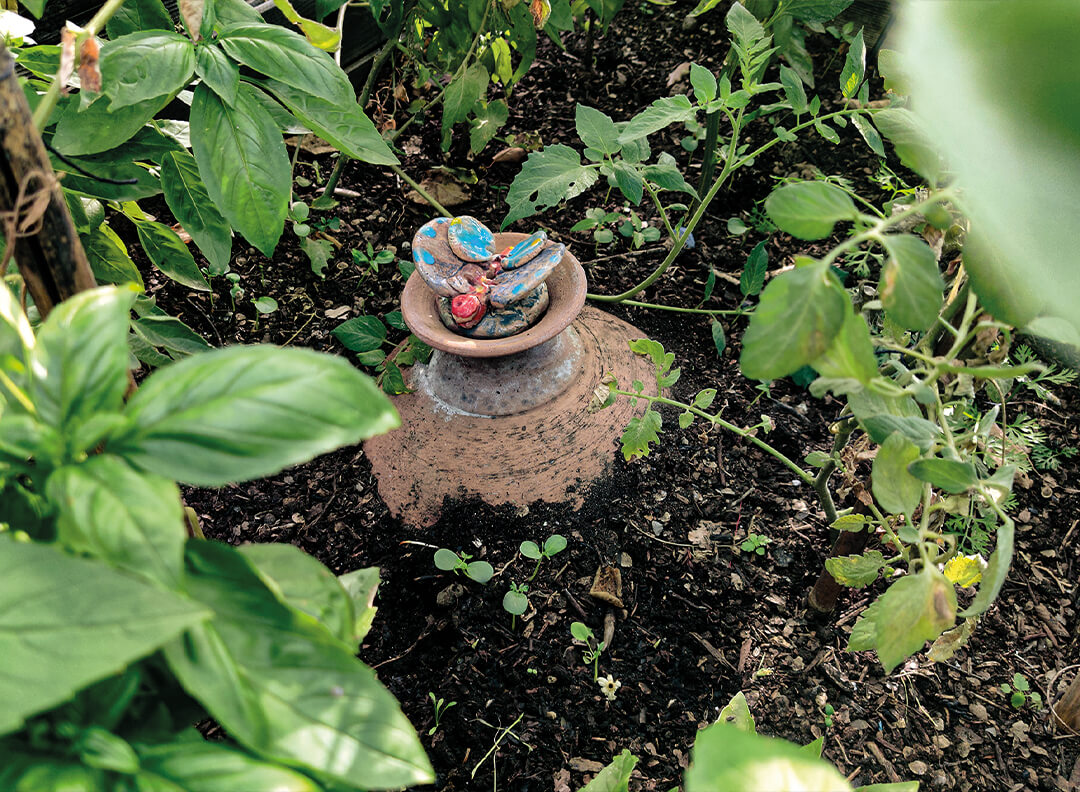
Good practices #4
Plant clay pots
In his novel “The Evolution Man,” Roy Lewis tells the story of a bizarre group of cavemen and the efforts they make to survive and evolve by efficiently managing natural resources.
The drought this past summer makes reading his enjoyable book highly recommended (and not just because we all really need a good laugh). The moral of the story is: “Live as if the entire future of humanity depended on your commitment; because after all, it might.”
Start answering the call of the cavemen and our planet by burying terracotta ollas full of water in your pots and gardens. The porosity of the container allows water to seep out in exactly the right amount that the soil and root system of the plants require and will help you grow lush, vigorous crops. Without wasting even a drop.
Giacomo recommends spreading a nice straw mulch to reduce water evaporation from the ground.
Good practices #4
Plant clay pots
In his novel “The Evolution Man,” Roy Lewis tells the story of a bizarre group of cavemen and the efforts they make to survive and evolve by efficiently managing natural resources.
The drought this past summer makes reading his enjoyable book highly recommended (and not just because we all really need a good laugh). The moral of the story is: “Live as if the entire future of humanity depended on your commitment; because after all, it might.”
Start answering the call of the cavemen and our planet by burying terracotta ollas full of water in your pots and gardens. The porosity of the container allows water to seep out in exactly the right amount that the soil and root system of the plants require and will help you grow lush, vigorous crops. Without wasting even a drop.
Giacomo recommends spreading a nice straw mulch to reduce water evaporation from the ground.



Jump into the circle!
A Il Bisonte scegliamo ogni giorno di impegnarci per dare un contributo concreto al futuro delle persone e del pianeta. Da oltre 50 anni produciamo borse e accessori che possono essere curati, riparati e riutilizzati per una vita intera.
Oggi il nostro impegno ha anche il suo luogo del cuore: un giardino segreto nel centro di Firenze, che abbiamo deciso di far crescere e di condividere con chiunque creda, come noi, nel valore della natura e di chi se ne prende cura con amore.
Per scoprire di più su come, con i tuoi acquisti, puoi sostenere i nostri progetti di economia circolare autentica e alternativa, visita ILBISONTE.COM
If you’d like to make a contribution, a direct transfer can also be made to the Orti Dipinti Association, via IBAN
IT 34 P 02008 02849 000101667158
or you can write to
info@ortidipinti.it
to donate soil, wood, gardening tools, organic plants and seeds.
Jump into the circle!
At Il Bisonte we choose to commit ourselves every day to making a concrete contribution to the future of the planet and its people. For over 50 years we have been producing bags and accessories that can be cared for, repaired and reused for a lifetime.
Today our commitment also includes a secret garden that is dear to our hearts, right in the center of Florence, which we have decided to help cultivate and share with anyone who shares our belief in the value of nature and those who lovingly take care of it.
To find out more about how you too can support our authentic and alternative circular economy projects through your shopping, visit ILBISONTE.COM
Se anche tu vuoi dare il tuo contributo, puoi fare un bonifico direttamente sul conto corrente dell’Associazione Orti Dipinti, tramite IBAN
IT 34 P 02008 02849 000101667158
oppure puoi scrivere a
info@ortidipinti.it
per donare terra, legno, strumenti per il giardinaggio, piante biologiche e semi.